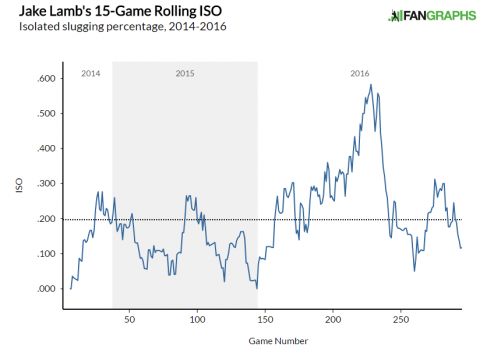Is Jake Lamb’s value still in question?
When Torey Lovullo was hired as manager of the Arizona Diamondbacks, one of the early remarks that was made centered around Jake Lamb. In that, Lovullo stated that Lamb would be the team’s everyday third baseman, something that apparently needed clarification after a career year in 2016. While it may not have been a necessary question to answer, after Lamb turned in an explosive year at the plate, it certainly spurred my thinking as to whether or not Lamb is as valuable an entity on the fantasy side of things as some (read: me) might think he is.
There are a few interesting elements of Lamb’s 2016 to be discussed. He experienced a major surge in power brought about by some swing changes and a largely healthy season. He struggled mightily against left-handed pitching, but was also relatively limited in his opportunities against southpaws. He also tailed off relatively seriously in the second half of the season, with his health again limiting his performance at the plate. There are some things to be rectified in his game, certainly, but we’re looking at a player that, if completely healthy in 2017, could be a tremendously valuable entity at the third base position.
First, the power. Lamb slugged 29 home runs and finished with an .840 OPS. This was a guy who had 10 home runs combined in the previous two seasons and managed an OPS of just .716 across 390 plate appearances in the previous year. That OPS ranked near the top of baseball heading into the All-Star break. Lamb’s noted swing changes, which led to a drop in his hands and less of a tomahawk type motion toward the ball, allowed him to generate stronger contact that featured more left. The result:

Obviously there’s that decline in the second half of the season that we’ll get to shortly. But the results at the height of his 2016 campaign are obviously stellar. That .260 ISO that he finished with on the season ranked fourth overall among third sackers, trailing only names like Nolan Arenado, Josh Donaldson, and Kris Bryant. There’s something to be said about the fact that he was still able to get that type of figure into the final line on the season, given his woeful second half of the year.
A primary concern of any potential Lamb owner is going to be his struggles against left-handed pitching. The following represents Lamb’s splits against the two sides:
| PA | AVG | OBP | OPS | ISO | K% | BB% | |
|---|---|---|---|---|---|---|---|
| vs. RHP | 413 | .271 | .346 | .898 | .319 | 25.4 | 10.1 |
| vs. LHP | 110 | .164 | .279 | .625 | .197 | 27.9 | 13.2 |
For one, it certainly doesn’t help that Chip Hale was absolutely terrified of hitting Lamb against lefties. Past struggles be damned, he didn’t give him anything resembling a proper opportunity to work out of them. Lovullo seemed to indicate that in Lamb being the everyday guy, Brandon Drury will get his ABs elsewhere, rather than stepping in for Lamb against left-handed pitching. That’s definitely encouraging, as we’ll at least get an opportunity to see if Lamb can have marginal success against left-handers after a season of mashing right-handed pitching in a much larger sample size. If anything, his approach being relatively similar leaves me optimistic. If this was a situation where his strikeout and walk rates were drastically different, I’d be less so. But given how tight the figures are within each other, it could indicate some sort of positive signs down the road.
One additional sign that Lamb remains a valuable at the plate is simply his ability to make hard contact regularly. His 39.4% hard hit rate was the highest of his career, trailing only Matt Carpenter, Donaldson, and Bryant. He demonstrates a sound approach, with 4.06 pitches seen per plate appearance, as indicated by his solid walk numbers. When you combine those two factors, it would appear that Lamb is relatively well set for sustained success in the future, provided his health ceases being an obstacle.
As I touched on back in September, as impressive as Jake Lamb’s first half was, his second half of 2016 was equally as brutal. He hit just .197 in the second half of the season, while that ISO shrank to just .184. There were some other factors at play as well, but a hand injury can be largely attributed to those second half woes. Should we read more into them and attribute it at all to the fact that he had accrued over 200 more plate appearances than he had in the previous season? It’s hard to be too alarmed, because the walk rate was almost identical and the strikeout rate rose ever-so-slightly. So there aren’t legitimate warning signs of fatigue.
It’s extremely hard to look at the skill set that Lamb brings to the plate and question his offensive upside. He’s a smart hitter with now established power and an ability to make strong contact. You’d like his strikeout rate to be a bit lower and perhaps for him to find more success against left-handers, but these are things that can be improved with time and at-bats, especially in regard to the latter. Is it fair to be bullish on him because of those shortcomings? Probably. But, in short, his second half hasn’t really made me any lower on him and am expecting big things from a healthy Jake Lamb in 2017.
“Is it fair to be bullish on him because of those shortcomings? Probably.”
I may be misreading this, but I think you mean bearish, not bullish.
Either way, good article, thanks for putting it up.
Yup, bearish. But I could really go for a rack of lamb right now.